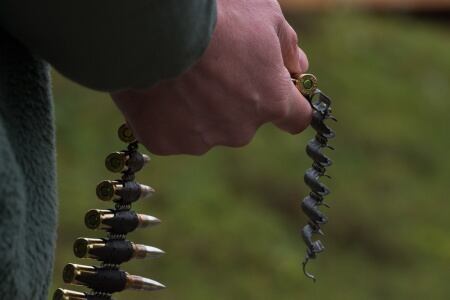The Air Force said Wednesday installation commanders will be authorized to implement three programs that grant some service members the right to carry weapons, giving their bases additional security.
The programs commanders may implement are the Unit Marshal, Security Forces Staff Arming, and Law Enforcement Officer Safety Act, the Air Force said in a release. The Air Force is focusing on new protocols following various mass shootings on installations, most recently, on a recruiting station and a Navy Reserve Center in Chattanooga, Tennessee.
"None of these programs gives the installation commander authorizations they didn't already have the authorization to do," Maj. Keith Quick, Air Force Security Forces Integrated Defense action officer, said in the release. "We are now formalizing it and telling them how they can use these types of programs more effectively."
Quick said the service looked at active-shooter statistics across the country and many incidents "ended without police intervention because there was somebody there who had a concealed carry permit or somebody interdicted the active shooter."
"These programs allow commanders the ability to arm additional trained airmen who could interdict before police arrive and are trained to stand down when police arrive," he added.

A Security Forces airman holds ammunition during a marksmanship competition in November.
Photo Credit: Senior Airman Damon Kasberg/Air Force
The newest program, Unit Marshal, gives airmen permission to work with security forces to train them to open carry an M9 pistol in their duty location, the release said.
"We are calling it a subset of the security forces augmentee program," Quick said. "The traditional augmentee program was established for security forces squadrons that didn't have enough personnel to cover installation security and we would ask for personnel from other work centers across the base."
While those airmen handpicked for the Unit Marshal program will not act as first responders in an event of an emergency, the squadron commander who "has a perceived threat" can request these airmen as additional security. Those under UMP will have proper use of force and weapons training, and will not engage "unless confronted directly by [an] active shooter."
The second program, Security Forces Staff Arming, would enable more security forces members — who have the appropriate Air Force specialty code and who work in staff billets at the squadron, group, wing or major command — to carry a government-issued weapon while on duty with the approval of the installation commander.
This program is similar to the Law Enforcement Officer Safety Act program, the third sanctioned Air Force program; however, the LEOSA law applies to security forces members both past and present:
As with their civilian counterparts, LEOSA is designed to give some service members who have another day job, such as National Guard or Reserve members who work in law enforcement, the ability to carry personal weapons to their next location without violating other DoD or federal laws.
Members who can apply for a licenses under LEOSA are service members who are actively serving military members under Title 10 and Title 32, as well as separated or retired members as long as they meet the requirements and are cleared by both the Air Force and the contractor providing the license.
"This affects base personnel because we have given the option to the installation commander to allow security forces members to carry under LEOSA on the installation while they are off duty," Quick said. "With installation commander's approval, I could go to the commissary on Saturday and stay armed and concealed while conducting my business on the installation and leave. It's not for work purposes."
In October, Defense Secretary Ash Carter issued additional directives for better security at military recruiting stations and other small, remote facilities aimed at preventing another attack like this summer's shooting in Chattanooga which left five service members dead.
Efforts in the Defense Department-wide directive called for more training alongside local law enforcement, accelerating use of extra "physical security enhancements," and improving mass notification alerts meant to inform local authorities and other nearby military personnel when there are specific threats or attacks already unfolding.
Oriana Pawlyk covers deployments, cyber, Guard/Reserve, uniforms, physical training, crime and operations in the Middle East, Europe and Pacific for Air Force Times. She was the Early Bird Brief editor in 2015. Email her at opawlyk@airforcetimes.com.





